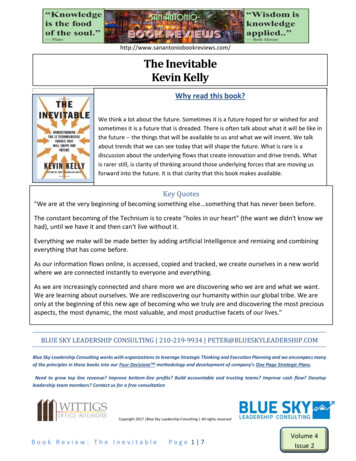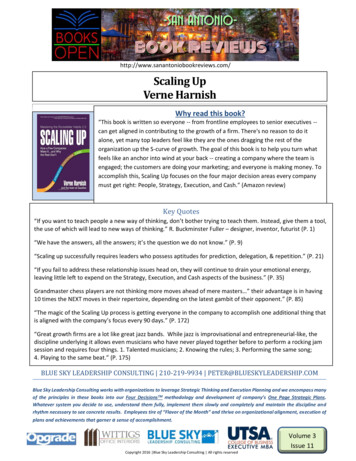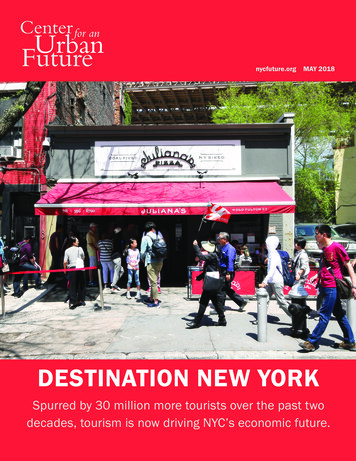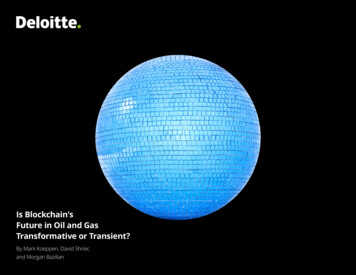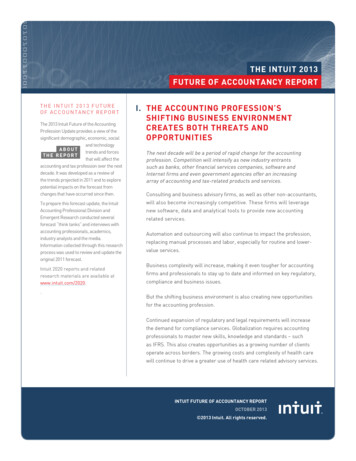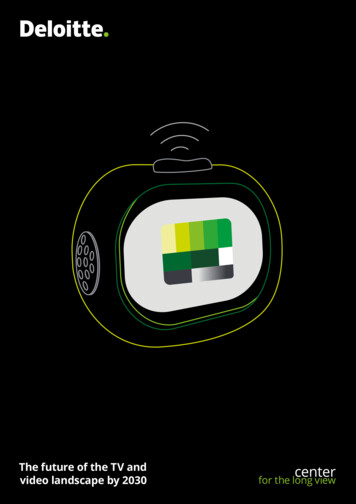
Transcription
The future of the TV andvideo landscape by 20301
The future of the TV and video landscape by 2030 More info and the video:www.deloitte.com/de/future-tv-video02
The future of the TV and video landscape by 2030 040507111323252603
The future of the TV and video landscape by 2030 Introduction:a market on the move“On-demand-services will disrupt the TV and video industry,” “New marketplayers such as Netflix or Amazon will soon replace traditionalbroadcasters,” “Consumers’ demand for TV and video consumption isfundamentally changing.” Established players are increasingly confrontedwith this kind of alarming news about their positioning within the futureTV and video landscape.But will these dramatic predictions reallycome true? TV and video are indeedfacing much uncertainty, and the extentof change in the sector is hard to foresee.Streaming services no longer serve as just aplatform for movies and TV shows—they arealso investing in producing and licensingtheir own content. This places them indirect competition with the traditional TVand video industry. At the same time, TVchannels and media organizations arestarting their own on-demand offerings.Also, large content producers are setting uptheir own streaming services.From another perspective, on-demandservices have quickly changed consumers’demand for TV and video consumption.The Deloitte Digital Media Trends Survey2018 states that almost 48% of all UnitedStates consumers stream television contentevery day or week.1 Likewise in the UnitedKingdom, streaming video services havegained in importance; already, 41% of allconsumers purchased such a service in theUnited Kingdom.2 Even in the moreconservative German TV market, 44% of thepopulation make use of subscription-basedvideo-on-demand (SVoD) at least once aweek.3 With the success of video-on-demand(VoD), consumers increasingly expectrelevant content accessible at any time, inany place, and in the format that best fitstheir needs.This rapidly changing market landscapemakes future predictions difficult, if notimpossible. We therefore adopted a moreholistic approach—and we now invite you totravel with us to the year 2030 to take a peekat four scenarios envisioning the future of TVand video. Our scenario approach does notaim to predict the most likely outcome butrather illustrates what could plausiblyhappen in the world of TV and video. It alsosuggests how today’s market players mightadapt to deal with the many changes anduncertainties there will be along the way.Fig. 1 – Average weekly video content consumption (in hours)Among Total Consumers2723222220151081716151787Live broadcast TVStreaming ngdomChinaDigital Media Trends Survey 2018 (United States) ; 2 Deloitte’s Digital Democracy Survey 2018 (global); 3 Deloitte Media Consumer Survey 2018 (Germany)04
The future of the TV and video landscape by 2030 Scenario thinkingThe highly dynamic TV and video marketis characterized by emerging new marketofferings, disruptive digital players, andrapidly changing consumer requirements.In this uncertain environment, the strategicsteps of relevant stakeholders will becrucial factors influencing the future marketlandscape. What they decide today will havemajor effects on their future consumerrelationships, the market structure, andtechnological standards.Conventional strategic analysis seldommanages well in such highly uncertainenvironments, whereas scenario designis one approach that can look beyond theusual planning horizon of three to fiveyears. While predicting the future is clearlyimpossible, scenario design isolates the risksand opportunities of certain strategic issues.It helps in developing robust strategies thatwill work in different potential futures.It is thus necessary to generate a set ofscenarios, each of them describing a specific,plausible world of the future whichsubstantially differs from the others.The objective of scenario design thus is notto identify future events, but rather toemphasize relevant forces that move thefuture in different directions. Scenarios arenarratives of alternative future environmentsin which today’s decisions might play out:they are neither predictions nor strategies.By making the driving forces visible, strategicplanners can consider them and adapt theirstrategy accordingly.05
The future of the TV and video landscape by 2030 Scenario design is an approach thatcan look beyond the usual planninghorizon of three to five years. Ithelps develop robust strategiesthat will work in different potentialfutures.06
The future of the TV and video landscape by 2030 The underlying driversand how we derived themThe foundation of our scenarios is acomprehensive set of underlying driversthat potentially shape the future of the TVand video industry. We therefore conductedexpert interviews and made use of ourunique external environment analysis basedon Natural Language Processing (NLP)algorithms. The resulting drivers were thenclustered into social, technological,economic, environmental, and politicalfactors (STEEP) and rated with regard to theirdegree of uncertainty and their impact onthe TV and video industry (see Figure 1).Traditional TV and nonlinear contentofferings will coexist. New and existingplayers will reposition along the valuechain in a partly consolidated market.07
The future of the TV and video landscape by 2030 HighFig. 2 – Driver evaluation according to degree of impact and degree of uncertaintyImportanceof livecontenton TVRelative importanceof linear broadcasting in contrastto non-linear/ on-demand servicesRole of OTTsQualityof digitalinfrastructureRegulationof mediacompanyownershipMediumDegree of ImpactDigitalizationof video/ TVproductionprocessesNationalcontentquotasDegree ofinterdependencebetweensocial mediaand TVTVadvertisingmeasurementAbility of AI toinfluenceaudienceSize ofsupplierecosystemsCapabilityof gth andformat ofvideoadvertisingDependenceof localproductionson subsidiesGlobalmedia marketconsolidationAvailabilityof All-IPmedianetworksAbility of AItools topredict contentacceptanceContentfocusDisruptivechangesin vanceof globalaudiencePoliticalinfluenceon alityofferingsSocietyEnvironmentCooperationbetween playersPoliticsBroadcasterroleNumber ofcontentproducersDevelopmentof cation of sport/eventlicensingOwnership ofsports rightsZone of gdata privacyPiracyDiversificationof playersin the TV/ videomarketAveragetimespent withTV/ videoIn-carrelevancyConvergence ofadvertisingmarketsMediumDegree of alcapability ofgeneralpublicAttractivenessof nationalvideo sectorfor talentsMobilerelevancyDemand for socialcontent/ user-generatedcontentEducationon media/video usein schoolsFocus ofpay-TVTransmission/FrequencyTV asenablerfor socialinteractionMultiChannelNetworksFocusof ceof theEuropeanUnionDistributionof TV cus of ilt-inmonitorsensorsNetneutralityDemand forin-home, largescreen entertainmentVerticalintegrationVideo/ TVconsumptionbehaviorPrice oftechnologicaldevicesLowOwner of theadvertisingrelationshipConvenience oftechnological progressPolarization ofadvertisinginto salesand brandLevel ofchildprotectionHolographicTVLevel ofmarketregulationAdvertisingsalesapproachLevel of intellectualproperty regulationIntroduction ofContentmedia regulationrightsfor online/ mobilepure offeringsAdvertisingfocusProducerRequirementsfor employeesin mediaInnovativecapabilityof videosuppliersBroadcasterrevenue streamsMarket entryof tech /internetgiantsDemand foron-demandcontentLevel of exclusive contentin national broadcastingMarket entry oftotally new playersDemandfor micropaymentsLength ndfor newforms onsin nationaladvertisingAttractivenessof nationalvideo sectorfor talentsPlacementof advertisingNewcategoriesof videodevicesRatio ofpay-per-usevs.subscriptionpaymentsDegree ofpersonalizedcontentHighEconomics08
The future of the TV and video landscape by 2030 In this way, we identified the two relevanttypes of driving forces for our scenarios: Drivers with a high impact and with a clearlypredictable evolution (see the chapter onExpert Predictions) Highly uncertain drivers with a high impacton the TV and video industry.Those drivers that are uncertain and highlyrelevant are located in the ‘zone of interest’,which is the fundamental section for ourfurther approach. The 23 driving forces inthe ‘zone of interest’ have subsequently beentested by measuring theirinterdependencies and relevance to eachother, and clustered according to theirdegree of relatedness. At the end of thisprocess, a combination of ‘criticaluncertainties’ was chosen, which createdthe most challenging, divergent, andrelevant scenarios. This process led to ascenario matrix, serving as the basis for ourscenario analysis. The matrix is built on twoaxes addressing the critical uncertainties byraising the questions, "What will theplayer structure look like?” and “Whowill have access to customers?"illustrated in Figure 3.Fig. 3 – Scenario Overview for the future of TV and video in 2030Platform ownerUniversalsupermarketLost in diversityWhat will the player structure look like?Revenge of thebroadcastersDriven bygobal playersWho will have access to consumers?Driven bynational playersContentendgameContent owner09
The future of the TV and video landscape by 2030 The axis “What will the player structurelook like?” re lects the changing providerlandscape in the TV and video industry. Thisdimension illustrates potential tendenciestoward internationalization with globalmedia players perhaps pushing nationalbroadcasters and content producers to thefringes. It also considers the fact that largedigital platform companies (DPCs) such asAmazon, Apple, Facebook, Google, or Netflixincreasingly enter additional stages of theTV and video value chain by, for example,producing their own content.The second axis or critical uncertaintythat will determine the future of video is“Who will have access to customers?”This raises the question of whetherbroadcasters, digital platform companies, orcontent producers will be able to leverage adirect consumer relationship—with massiveimpact on monetization options, eithervia innovative advertising or paid contentmodels.We see digital platform companies as themajor disruptors in the future TV and videomarket. By contrast, broadcasters andcontent producers face the greatest pressurefor change.10
The future of the TV and video landscape by 2030 Expert predictions:what we are certain aboutAs mentioned above, our scientific scenario approach identified a group ofrelevant influencing factors that our experts predict will have a distinctevolution. These factors will also have a significant impact on the future of TVand video as well as relevance for all four scenarios. The statements belowoutline this impact:Digitalization will change contentproduction, distribution, andrecommendation functionalities.All-IP becomes the standard for TV andvideo distribution. Fiber infrastructureand 5G networks will handle the massiveincrease in digital traffic caused by anincreasingly flexible and mobile use ofmedia offerings. Beyond that, they willstrongly drive the digitalization level ofvideo production processes. ArtificialIntelligence (AI) and analytics become keyelements of smart content discovery withintelligent recommendation functionalities.Traditional TV and non-linear contentofferings will coexist.Linear and on-demand content willbe equally important and will coexistpeacefully. Video-on-demand will soonbecome mainstream in all populationgroups; at the same time, linear TV remainssignificant. Especially live content suchas sports and major events will preservethe high importance of traditional, lineartelevision.Advertising becomes targeted.TV and video advertising will adapt tonew formats and increasingly focus onpersonalized ads. Leveraging consumerdata will enable stakeholders to hypertarget their ads and content, and thusmaximize customer experience and value.However, the extent of targeted advertisingstill depends on regulation and consumers’willingness to share their data. Advertisingmarketing will be something between afully automated process and individualsales negotiations.11
The future of the TV and video landscape by 2030 There will be moderate marketregulation overall.Market regulation will be more moderatecompared to the highly regulated mediaindustry today. The lower level of regulationfor online and mobile offerings leads toa reduction of the regulatory pressurefor all market players, especially for thetraditional media companies. In particular,lower regulatory pressure will lead to ahigher level of freedom when it comes tocooperation between market players andconcentration of media ownership. Netneutrality will continue to exist.Advertising and direct revenues willremain most relevant.Generating new revenue streams is ratherdifficult for the protagonists in the TV andvideo market. Innovative offers such asdemand-based pricing for content will notprevail to a major extent. In addition,consumer data will be only partly used inmonetization. There are only a few newdata-driven revenue streams forbroadcasters, as consumers show only amoderate willingness to pay with their data.New and existing players willreposition along the value chain in apartly consolidated market.The global media industry will be partlyconsolidated. Stakeholders will make useof strategic mergers, acquisitions, andalliances to strengthen their content qualityand distribution capability. Moreover,numerous market players will shiftalong the value chain by expanding theirbusinesses. Broadcasters will not only focuson their core competencies but also occupysome other positions in the value chain.Over-the-top (OTT) services become moreimportant in the future TV and videomarket, whereas tech players play a minorrole. Looking at content production, bothtraditional studios and non-traditionalproviders will be part of it.12
The future of the TV and video landscape by 2030 Journey into ourfour scenariosThe following scenarios demonstrate howdifferent the future paths of the TV and videomarket could be. Let us explore each oneindividually to see how they differ and what risksand opportunities might arise in the future.13
The future of the TV and video landscape by 2030 Scenario 1Universal supermarketIn this scenario, a few global digital platformcompanies have taken over the leading role inaggregation and distribution from national broadcasters.They control the TV and video market and have enteredall steps along the value chain, including creation,aggregation, and distribution of content and the directcustomer relationship. Like large supermarkets, each ofthe digital platform companies offers an extensive rangeof global and national content, only differentiated bysome exclusive productions and sports rights.14
The future of the TV and video landscape by 2030 Broadcasting as we know it today hasdisappeared. Since video content isdistributed in all-IP (Internet Protocol) andmainly online over the Internet, broadcastershave been through a painful process ofchange. They have evolved into purecreators of largely national or specializedcontent without any stakes in distribution orcustomer relationship. They are now asupplier of their own channels and streamsto the digital platform companies’ universalsupermarket. However, broadcasters remaina relevant part of the video landscape.Consumer demand for relevant content suchas news or local(ized) formats has saved theirexistence.At the beginning of the markettransformation process, consumers wereoverwhelmed by the quantity of contentavailable and the proliferation of contentproviders. That confusion quickly evolvedinto frustration. Subsequently, global digitalplatform companies exploited theirtechnological capabilities to develop smartselection and recommendation, supportedby artificial intelligence.Advertising, as well as consumerrelationships, has also shifted to the digitalplatforms. Broadcasters are dependent onthe revenue shares from digital platformcompanies and cut off from direct paidcontent and advertising revenues.Advertising agencies and traders havedisappeared, rendered irrelevant by digitalplatforms’ direct models of ad trading.Beyond that, their technological prowesshelped in implementing new, personalized,and interactive forms of advertising.In this scenario, regulators did not takesignificant steps to monitor and control thedigital platform companies’ market strength.Though the market is consolidated,access to local content is widely regarded asguaranteed. From the regulator’sperspective, the digital platforms are doing adecent job in catering to different culturaltastes and providing quality local content.In addition, they initiated the consolidationof the vendor landscape. The financialcapabilities of the global digital platformcompanies allowed them to acquireexclusive sports rights and produceglobal blockbuster content, displacingcomparatively smaller players such asbroadcasters and content creators fromimportant stages of the value chain.15
The future of the TV and video landscape by 2030 Scenario 2Content endgameIn the ‘Content endgame’ scenario, large globalcontent owners are the winners of the markettransition. They have integrated vertically along theentire value chain and started to withdraw andwithhold content from digital platform companies anddistribute via their own channels, bypassing theplatforms and establishing direct customerrelationships.16
The future of the TV and video landscape by 2030 Content has become the maindifferentiating factor in the video market,while technologies such as distribution,search, and recommendation areconsidered a commodity.Big content owners with strong programbrands and global reach target a globalaudience with costly blockbusterproductions and benefit strongly fromeconomies of scale. Smaller producers havebeen pushed out of the market. The varietyof content has decreased, but the qualityof global productions has reached newdimensions.Broadcasters have survived by shifting theirfocus solely to the creation of strong localformats. They have evolved into suppliers tothe big global content owners and benefitfrom the protection of national regulators.Digital platform companies have retreatedto becoming pure distribution channels,focused purely on technical delivery. Thedigital platform companies’ business modelhas changed fundamentally sinceconsumers are no longer paying for aspecific platform, but directly for theirpreferred content. Apart from advertising,freemium services have become a relevantsource of revenue for digital platformcompanies.As content really is king in this scenario,global content owners negotiate directlywith advertisers. New ad models on aglobal scale have proved to be beneficial forcontent owners and international consumerbrands. Finally, advertising partnershipshave been established in the market, withsponsoring and content marketing being themost important examples.17
The future of the TV and video landscape by 2030 Scenario 3Revenge of the broadcastersIn this scenario, national broadcasters have successfullyaccomplished their digital transformation and secureda strong position in the TV and video ecosystem.Broadcasters have evolved into digital platforms,established direct customer relationships, and deliveredon-demand content. During the transformation process,broadcasters developed excellent digital capabilities. Theyhave entered new services, such as targeted advertisingand recommendation functions, which had previouslybeen dominated by the digital platform companies.Furthermore, the high relevance of content for a nationalaudience puts broadcasters in a superior market position,supported by regulatory measures such as content quotas.18
The future of the TV and video landscape by 2030 National broadcasters and global digitalplatform companies coexist in the market.This guarantees a great richness of content.While national broadcasters focus on localquality content, digital platform companiessupply global productions and blockbusters.Viewers can chose whether they want towatch linear or non-linear content fromglobal or national sources.Apart from several content partnerships,technological alliances have also shapedthe market. All-IP network operators helpedbroadcasters during the transformationprocess with their expertise in digital mediadistribution and by leveraging customerdata. With their national footprints,network operators and broadcasters areideal partners serving the same regionalmarkets. The alliance resulted in an efficientdistribution of content via high-performanceplatforms with smart access to customerdata.In this technologically advanced scenario,broadcasters are gaining valuable customerinsights that are highly relevant toadvertisers. The collected user data wouldbe an effective enabler for fully personalizedadvertisement, but advertising is part of astrong regulatory framework with strict dataprivacy rules. Advertising agencies haveremained in the market and are helpingbroadcasters implement innovative adswithin the legal guidelines.Broadcasters also benefit from strongmedia regulation at a national level aslocal content production enjoys firmregulatory support. The strict national andEuropean regulatory regime is the answerto the threat of globally dominant digitalmedia companies. With correspondingmeasurement systems, broadcast industrybodies have secured a strong nationalmedia industry.19
The future of the TV and video landscape by 2030 Scenario 4Lost in diversityIn our fourth and final scenario, the TV and video markethas evolved into a diverse ecosystem with no dominantplayers. Instead, consumers are served by numerousdistribution platforms, a great richness of content, anda steady turnover of players in the market. Demandfor national content remains strong, so partnershipsbetween global and local players are widespread. The cleardistinction between content production and distribution isanother key characteristic of this scenario.20
The future of the TV and video landscape by 2030 Everyone does everything in this scenario.Global digital platform companies haveestablished direct customer relationships.Telecommunications providers,broadcasters, and content producers havealso successfully created their own digitalplatforms. Digital platform companiescontribute global formats such as highprofile series. To provide relevant localcontent they also forge alliances with localproducers. Network operators act assuper-aggregators. They provide access tocontent and structure the market from thecustomer’s perspective by offering guidanceacross platforms. Consumers are onlyinterested in content and therefore tend notto be loyal to any one platform.National broadcasters capitalize on theconsumers’ huge appetite for local news,sports, movies, and series. Broadcasterswho started their digital transformation atan early stage are using their own platformsfor content distribution. Others haveestablished partnerships with platformproviders, with the general trend towardsco-productions between broadcasters andglobal digital platform companies. All in all,national broadcasters remain independentand maintain their livelihood by variousrevenue streams.In this vivid and dynamic market, advertisingagencies continue to have high relevance.They systematically allocate advertisingbudgets and provide guidance withinthe complex TV and video ecosystem. Asdigital platforms facilitate personalizedadvertisement, agencies had to acquirecomprehensive data analytics skills. In thisway, they became indispensable advisors foradvertisers.The primary concern of regulators in thisscenario is the preservation of local contentand media companies. With their regulatorydecisions, they have strongly protectednational broadcasters and put them in aposition to compete against the digital andfinancial muscle of the large global digitalplatform companies.21
The future of the TV and video landscape by 2030 Fig. 4 – We clustered the main trends and drivers and prioritized two main forces influencing the future Platform owner21UniversalsupermarketLost in diversityDriven bynational playersDriven byglobal players34Revenge of thebroadcastersContent endgameContent owner1The TV and video market has evolved into adiverse ecosystem with no dominant playersand a steady turnover of market participants.2National broadcasting has been replaced by afew global digital platform companies.3National broadcasters retained their placeby successfully accomplishing their digitaltransformation.4Global content owners can leverage a directconsumer relationship, which places them inthe driver seat.22
The future of the TV and video landscape by 2030 Taking a closer lookLooking at the final set of scenarios, we see DPCs being the major disruptorsin the future TV and video market. By contrast, broadcasters and contentproducers face the greatest pressure for change. We will therefore take acloser look at the strategic options for those two stakeholder groups.Even though our four scenarios are highlydivergent, a few overarching implicationsare highly relevant for all of them. Firstly,broadcasters and content producers canno longer rely on their current marketpositions. To safeguard their businessmodels and future revenue streams,they need to be open to cooperation andalliances, even with their direct competitors.Joint production, distribution or evenplatforms are appropriate measures forcountering the threat posed by the DPCs.In parallel, regulators need to becomeless restrictive when it comes to alliancesbetween equally positioned players withinthe TV and video value chain. Broadcastersand content producers must work towardsconvincing regulators to permit suchcooperative models.processes, and mastering them is aprerequisite to being well-positioned in anincreasingly digital video market landscape.As a result, traditional players must attractdigital talent as well as creative minds; inaddition to technology, attractive andcreative content certainly remains king.Next to these overall implications, we havedifferent distinguishing factors in each of thefour scenarios, which affect the actualoptions for broadcasters and contentproducers. Depending on the respectivescenario, stakeholders must drawappropriate fundamental conclusions.However, the risk potential for each marketplayer must be analyzed separately in orderto develop individual strategic options.Beyond that, established broadcasters andcontent producers must continuously investin their technological skills. Technology hasbecome a core element of their business23
The future of the TV and video landscape by 2030 Universal supermarketsIn the Universal supermarket scenario, broadcasters and content producersneed to focus on the implementation and positioning of strong contentbrands. This branded content must be used to improve bargaining positionswhen negotiating partnerships with content distributors. Also, content brandsshould seek more international licensing and leverage. To secure additionalrevenue streams, broadcasters and content producers must extend theirbusiness models beyond the TV and video market into other fields, suchas merchandising.Content endgameLarger content producers need to invest more strongly in internationalcontent production--directly or via subsidiaries--to keep pace with their bigglobal counterparts. Besides this focus on content, larger producers muststrengthen the fields of customer relationships and advertising-marketing inthe Content Endgame scenario.Smaller broadcasters and content producers need to position themselves asinimitable national partners for global players through unique, local, andstrongly branded content. Furthermore, they must explore alternativedistribution channels through strategic alliances with DPCs or IP networkoperators.Revenge of the broadcastersIn this scenario, broadcasters must keep an eye on the general conditionsof the video market. They need to be aware of their political role and mustexert influence to prevent adjustments in the the regulatory frameworktowards a less strict regime.Lost in diversityIn the Lost in Diversity scenario, broadcasters and content producersmust clearly place the emphasis on their own strengths. In a world inwhich everyone does everything, only a strong, focused strategy andappropriate investments will secure the future market existence ofbroadcasters and content producers.24
The future of the TV and video landscape by 2030 MethodologyThe methodology of this study is basedon the proven scenario approach firstemployed by Shell, and then perfected byMonitor Deloitte. A seven-step scenariodevelopment approach (see image)applies the guiding scientific principles ofobjectivity, reliability, and validity. The studyis the outcome of a series of interviews,questionnaires, and workshops involvingTMT experts from the Deloitte EMEAnetwork and industry professionals as wellas experienced scenario practitioners fromDeloitte’s Center for the Long View (CLV).Scenario design starts by identifying thefocal question of the underlying issue.Since we could tell an infinite number ofdifferent stories about the future of the TVand video industry, we first had to agree onthe issue or strategic challenge we wantedto add
Amazon, Apple, Facebook, Google, or Netflix increasingly enter additional stages of the TV and video value chain by, for example, producing their own content. We see digital platform companies as the major disruptors in the future TV and video market. By contrast, broadcasters and
